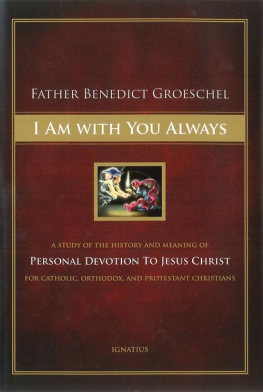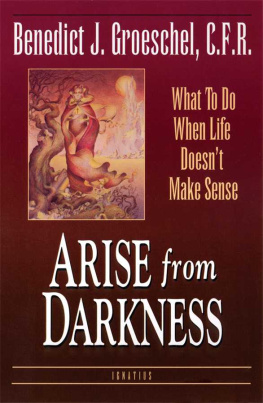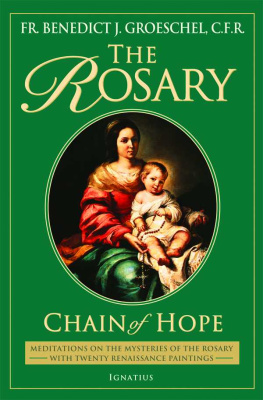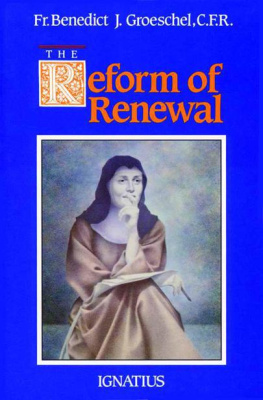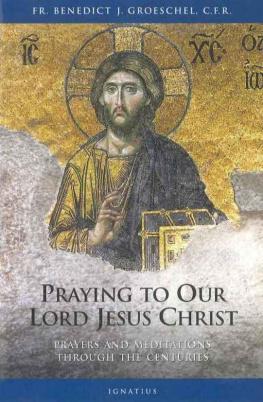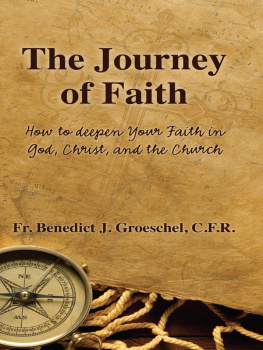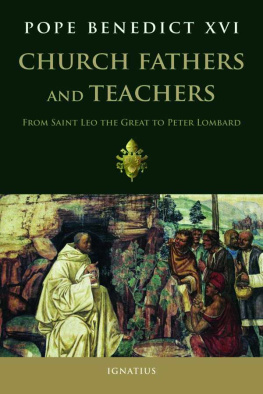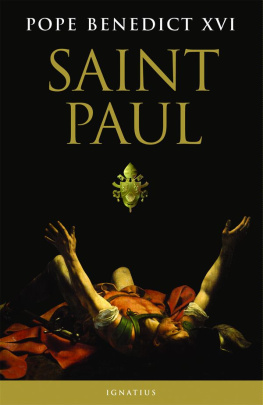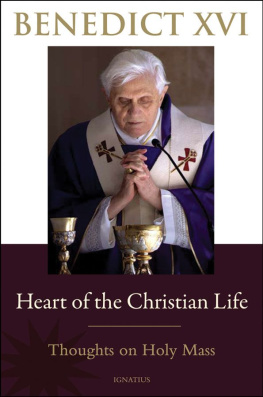I AM WITH YOU ALWAYS
FATHER BENEDICT GROESCHEL, C.F.R.
I A M WITH Y OU A LWAYS
A STUDY OF THE HISTORY AND MEANING OF
PERSONAL DEVOTION TO JESUS CHRIST
FOR CATHOLIC, ORTHODOX, AND PROTESTANT CHRISTIANS
IGNATIUS PRESS SAN FRANCISCO
Unless otherwise noted, Scripture quotations (except those within citations)
have been taken from the Revised Standard Version of the Holy Bible, Catholic Edition. The Revised Standard Version of the Holy Bible: the Old Testament, 1952; the Apocrypha, 1957; the New Testament, 1946; the Catholic Edition of the Old Testament, incorporating the Apocrypha, 1966;
the Catholic Edition of the New Testament, 1965, by the Division of Christian Education of the National Council of the Churches of Christ in the United States of America. All rights reserved.
Nihil Obstat : Monsignor Michael F. Hull, S.T.D.
Imprimatur : + The Most Reverend Dennis J. Sullivan, D.D.
Auxillary Bishop of the Archdiocese of New York November 2, 2010
The Nihil Obstat and Imprimatur are official declaration that this book is free of doctrinal or moral error. There are no implications contained therein that those who have granted the Nihil Obstat and Imprimatur agree with the content, opinion or statements expressed.
Cover painting:
Annunciation by Father John Lynch
Father Benedict has explained that in this painting, Father Lynch seeks to communicate the dynamism of the Holy Spirit filling the Virgin as she speaks with the archangel. Although the painting is done in the classical style, the artist has striven to present a quality familiar to contemporary believers.
Cover design by Roxanne Mei Lum
2010 by Ignatius Press, San Francisco
All rights reserved
ISBN 978-1-58617-257-2
Library of Congress Control Number 2010922768
Printed in the United States of America
To Pope Benedict XVI
in gratitude for
his devotion to Christ
and his openness to all
Christians and all who believe in God
C ontents
CHRIST FROM THE EARLY DISCIPLES TO THE AGE OF FAITH
CHRIST FROM THE RENAISSANCE TO MODERN TIMES
Acknowledgments
This book has been more than a decade in the making. So many people helped with it over the years that that I am afraid it is difficult not to leave someone out. I feel, however, that I must make the attempt to list as many as I can remember.
First of all I am deeply indebted to the team of personal editors whose help was indispensable: James Monti in the beginning chapters and Charles Pendergast throughout eight years of extraordinarily capable assistance. More recently John Collins has carefully helped with the completion of this book.
Dr. Ted Campbell of Southern Methodist University provided the initial inspiration for this work. As he has done for so many of my books, Fr. John Lynch provided a remarkable original painting for the cover, this time of the Annunciation, when the Son of God first came to be among us and to remain with us always. I am also very grateful to Dr. Timothy George of the Beeson School of Theology for his input on Evangelical spirituality. The exploration of Orthodox devotion was made possible by the staff of St. Vladimirs Seminary in Yonkers, New York, and their excellent library. I am indebted, as well, to the faculty of St. Nersess Armenian Seminary and particularly to Fr. Kerekin Karparian, pastor of St. Gregory Armenian Church in New Rochelle, New York, for their guidance on Armenian spirituality. Special thanks go to Fr. Michael Plekon for his advice and council on Eastern Christianity and to my co-worker Fr. Eugene Fulton, who is a Catholic priest of the Byzantine Rite. Finally, I am deeply grateful to the sisters and the staff of the Corrigan Memorial Library of St. Josephs Seminary in Yonkers, New York.
We have carefully sought and obtained permission to cite many works and authors in this volume and we are grateful for all permissions we have received. Special mention must be made of the Classics of Western Spirituality series published by the Paulist Press and of my friend Richard Payne who guided this great publishing project. Finally I want to express my thanks to the Franciscan Friars of the Renewal, many of whom assisted me in various aspects of this project, and to the staff of Trinity Retreat, who provided much support and encouragement. My thanks go, as well, to David Burns and Helen Carbone.
I will always keep in my prayers those who assisted us in this very substantial project, which had to be done during the spare time of all involved, in between many other responsibilities.
Introduction
The Unique Qualities of Christianity
The study of the various religions of the world reveals that although they have much in common, each is unique. This is especially true of Christianity, which has at least three distinct characteristics. First, it is the religion of the God who suffers and dies, who assumes the full scope of the human condition with all its tragedies. Second, most of Christs followers believe that Jesus Christ, risen from the dead, is still close to them. They believe that His voice is heard in the Scriptures and that His mysterious presence is experienced in the sacraments. Even the most unsacramental of Protestants acknowledge and respond to the presence of Jesus Christ and the Holy Spirit in very personal ways. Nothing in the practice of most sacramental Christians denies the personal experience of Christ apart from the sacraments, for example, in personal prayer. Quite the contrary is true. The medieval Catholic writer St. Bernard of Clairvaux speaks of three comings of Christ: at the Incarnation, at the Last Judgment, and His invisible presence among those who believe in Him. Christs words Behold, I am with you always, to the close of the age (Mt 28:20) are embraced wherever Christianity is taken seriously.
The belief in Christs presence gives rise to Christianitys third unique characteristic: personal devotion to Christa response to Him as friend; a deeply felt sense of reverence, gratitude, trust, dedication, repentance for our faults; and ultimately an all-encompassing impulse to love and serve Him. This experience is properly called Christian devotion. One might object that this personal response is not lacking in the other monotheistic religions. That is true. Because the Son of God took on humanity, however, giving God a human face, Christians are capable of a very personal, intimate, and loving devotion to Him. This differs considerably from the relationship of a devout Jew or Muslim with the Lord in which the most profound experience of God is likely to be one of reverence and awe.
This book is about Christian devotion, its meaning and importance and its many varieties of expression. It is interesting to note that throughout its two-thousand-year-long history, devotion to Christ has been amazingly similar across the sadly divided branches of Christianity. This largely unrecognized similarity has been obscured by polemical battles over theology and the interpretation of history. In doing this study over several years, I have found very little explicit recognition of the essential unity of Christian devotion despite obvious similarities. With the coming of ecumenism in the twentieth century, there was some acknowledgment that we worship the same God and follow the same Jesus Christ, but few realized that the best representatives of the various branches of Christianity loved their Founder in much the same way and expressed their devotion in similar terms, consciously and unconsciously borrowing from one another.
Doing the research for this volume has been a constant source of delight and amazement. In the last half century alone Orthodox iconography, or sacred art, permeated European Protestantism and brought a new flavor to all Europeans seeking to worship Christ. We have seen Protestant Pentecostals influencing Roman Catholic worship, while Catholic charismatics were seen in St. Peters Basilica, with the Pope accepting their experiences enthusiastically. Spiritual writers of the Catholic tradition, like Thomas a Kempis, Francis de Sales, and Thomas Merton, are being accepted across the spectrum of Christian denominations. As we have said, in all these expressions the central focus is love for and devotion to Jesus Christ.
Next page
